 | F-4U CORSAIR FIGHTER. |  |
|---|
| Terran United States Marine Corps. | Terran United States Marine Corps. |
|---|
The F4U Corsair is a carrier-ready fighter/attack/bomber Warbird based on the Terran American Empire's Marine Corps fighter of WWII; It was also the First of the series accepted into 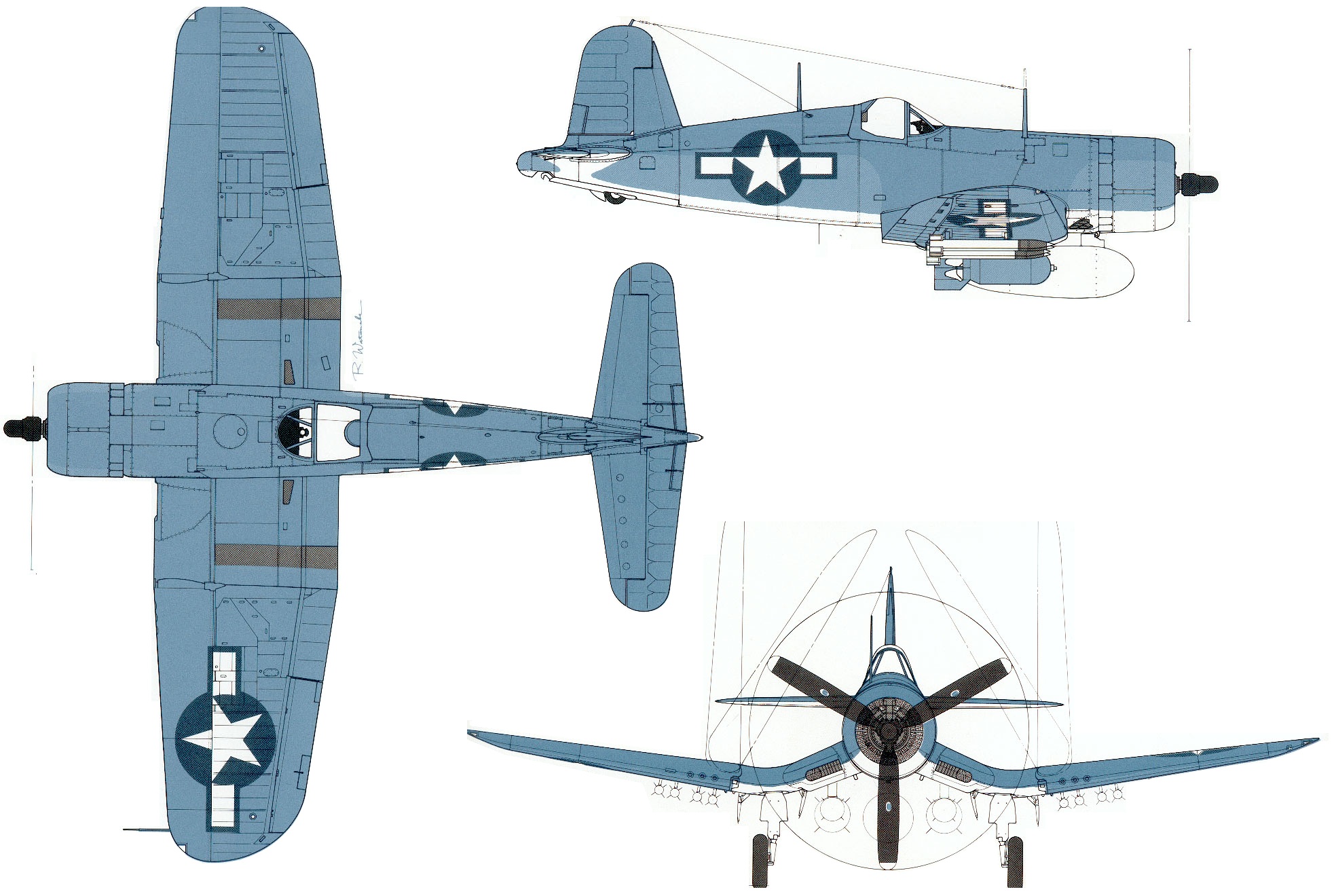 | | F-4U Line Drawing. |
|---|
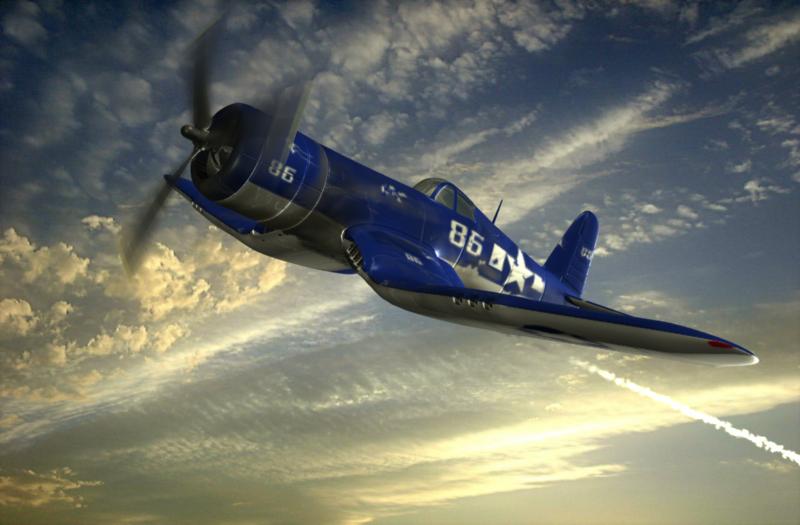 | 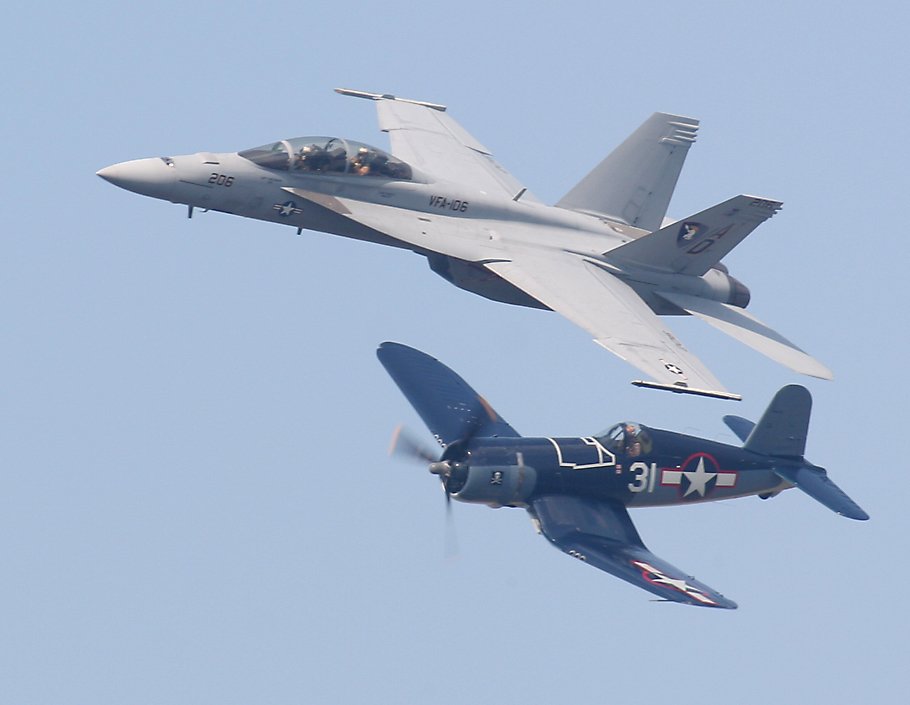 | Marine F-4U In Action (date unknown).
| First F-4U Being Taken Into Service Under Escort. |
|---|
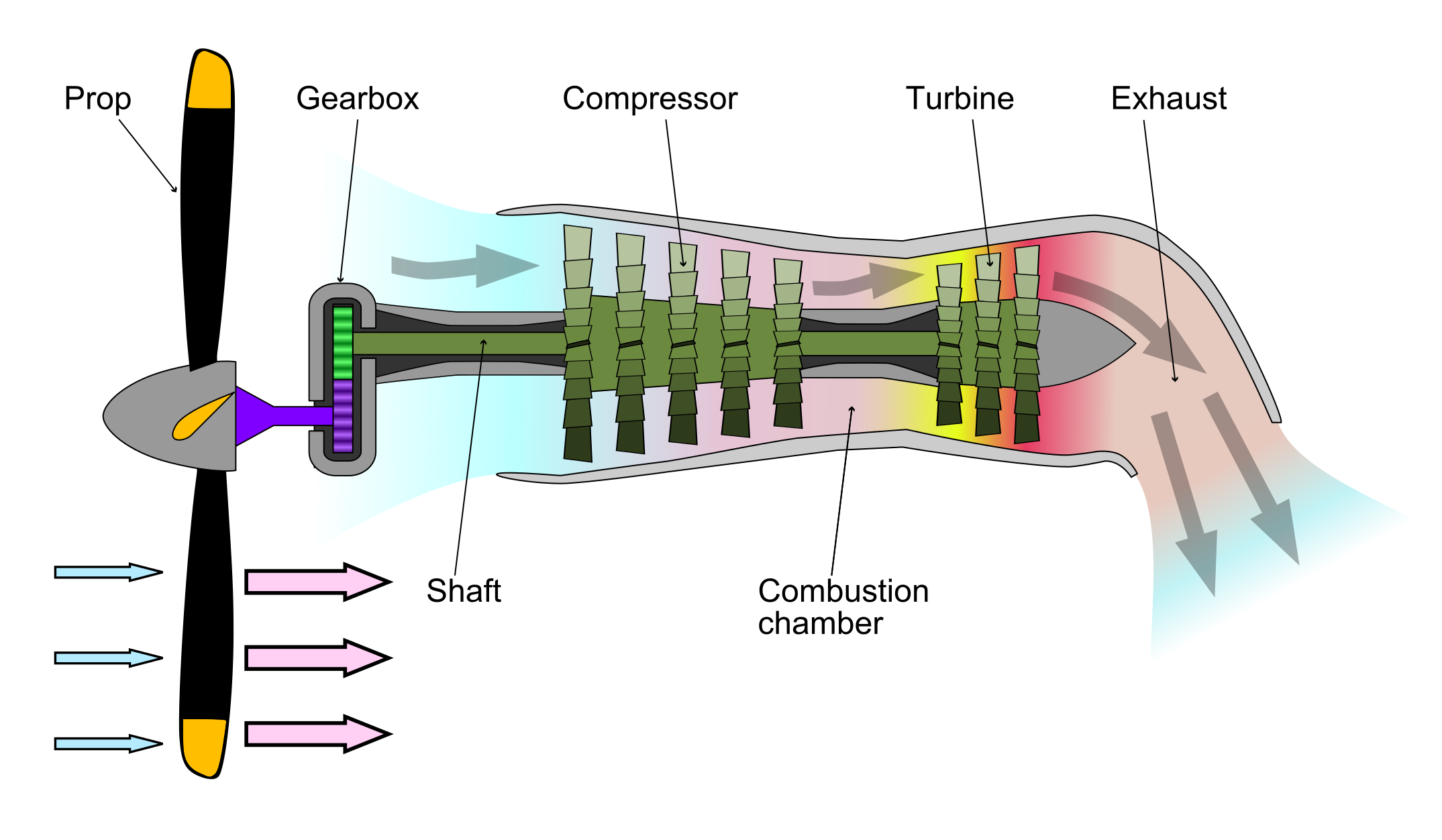 | A Very Simplistic Diagram Of How A Turboprop Angine Works;
The jet engine turns the prop,which
in turn pushes air over the wings. |
|---|
REF Service, via the Marine. 25,056 were accepted in the First production run (174 squadrons worth). They are equipped with dual-phase aeration, tractioning drives (as auxiliary), laser and chemical cannons (for use in space), can be remotely operated, and can float in the water if shot down (though it can't take off from the water afterwards). More importantly, it's significantly more heavily armed- An amazing TWENTY-SEVEN wing hardpoints (although 4 of them are restricted to missiles and one is restricted to either fuel/air tank or LRM).Sensors And AvionicsThe sensors and avionics of the prototype F-4U were taken off a retired VAF-6. While these were multiple generations ahead of the original fighters, they weren't far enough for UGC and in production were switched out for standard UGC fighter and attack aerospacecraft sensors and avionics.CockpitFor trainee pilots, the F-4U has an all-digital flight instruments. The canopy itself provides tracking information on surrounding forces, with friendly forces in blue, enemy in red, civilians in green, and unknowns in yellow. Speed, course over history, known or probable condition, etc. are also shown. The primary flight controls are a centerline mounted controller and a pair of throttles. For instructor and combat pilots, the pilots also have thinking caps that can read their thoughts, increasing their combat efficiency. The integrated control panel (ICP) enters communications, navigation, powerplant management, and autopilot data.PowerplantThe primary powerplant is a Pratt & Whitney U-1300 Hydrocell turboprop engine (output 3,500 hp at 2,100 KHw).Secondary power is supplied by wing and fuselage mounted solar panels (output 1,500 hp at 1,000 KHw).Flight SystemsThe F-4U pioneered the use of grav pods in Warbirds and pioneered the use of grav pods as a secondary system. Normal aerofoil wings supply lift, though grav pods can be used when necessry.OperatorsCurrently only the Marine flies the F-4U in actual combat of the REF, though many RDF's do as well for area patrols and law enforcement work; All branches of the REF use the Corsair for training. In addition to ground support for Marine infantry, the Marine also have two plane, Cinderella and Aurora, which is part of the Blue Angels Flight Team as the Honor Guard Sergeant. She is always flown by a female E-5 or above Marine enlisted, and will fly in into an airport or field 5 minutes ahead of the main team's demonstration and escort Fat Albert during take off. The Honor Guard are the only craft in the team with nose art, with Cinderella and Aurora having topless pinup versions of their names and Fat Albert with a cartoon version of the plane with a wrench in it's hand.Many mercenary groups fly them as well, along with various militias and civilian demonstration teams.Weapons SystemsThe F-4U is unprecedented in it's firepower, at least in terms of Warbirds; There are 08 underwing hardpoints on the outboard wings (past the point of the bend) and 4 more on the over-wing. (The wings must be cleared to fold up.) There is a hardpoint on the inboard underwing and another on the undercarriage of the fuselage itself. The inboard wings and undercarriage hardpoints must be taken special care- They fire right THROUGH the propellers. Though this is an issue with all Warbirds (except the P-38), it's especially dangerous with the F-4U because there are more hardpoints behind the props.Space OperationsThe F-4U can be launched from orbit, but can not fight in a factory configuration in orbit. It is capable of flying in orbit for about 20 minutes and then entering an atmosphere. To convert them to space combat takes ripping the main powerplant and drive system out. This is cost-prohibitive and fairly ineffectual, especially in a manned variant (though some colonies and private militry contractors are known to sometimes do it).ManufacturingIn an unprecedented move, Galactic Defenses, Ltd applied for and received permission to purchase a used Neotech Factory to produce the fighters- To exclusion. (They actually produce all of the Warbirds series, plus anything needed for the planes, including fuel, etc- Even training pilots, including REF Warbird pilots.)Name: F-4U Corsair.Model Type: WarbirdClass: Patrol Fighter/BomberCrew: One; A two seat trainer/special operation variant is available, but not common.Passengers: One on shorter flights.MDC By Location: |
Fuselage-
Cockpit-
Wings (2)-
| 200
90
100 | Taileron (1; Reaches between tails)-
Rudder-
Props (4)- | 75
75
80 each |
| Speed and Statistical Data: |
Flying: 600 mph.
Range In The Air: 100,000 miles; This is SEVERAL times around the world on most planets. Can be refueled in the air.
Service Ceiling: Tranatmospheric.
Climb Rate: 4,000 ft./min.
Wingspan:Folded Down: 41 ft.Folded Up: 13 ft 6 in.
Length: 38 ft 1 in
Weight: 24,800 lbs max/12.4 tons.
Height: 13 ft 8 in
Cargo: Pilots supplies only. | Power Systems: Primary:One Pratt & Whitney U-1300 Hydrocell Turboprop Engine; Output: 3,500 hp at 2,100 KHw.Secondary: Wing and Fuselage Mounted Solar Panels; Output: 1,500 hp at 1,000 KHw.
Flight Systems:Primary: Anti-Grav PodsSecondary: Aero-Foil effect in emergency.
Cost and Availability: 200,000credit to authorized purchasers; Always available to authorized purchasers.
Black Market Cost and Availability: 5 to 50 MILLIONcredit- Fluctuates WILDLY; Not very common. |
| Weapons Systems: |
|---|
1. Six .50 Caliber M-3 Machineguns (6 between and 2 outboard of the cockpits): The general purpose weapon of the Warbird series; A fully automatic, heavy machine gun has been around since the early 20th Century on Earth, and nearly identical ones have existed just about everywhere. In all mechanical functions, the Regult Series Battle Pods auto-cannon is so similar that some would call them identical; Only the caliber is significantly different (and thus, the engineering is SLIGHTLY different). The addition of Depleted Uranium rounds to the available inventory has added to the lethality of the .50's significantly. Also, during the War with the Regent, Plasma-662 propellant was developed; The charge was reduced to exactly emulate the effect of Cordite propellant, so it does NOT effect the damage.
Purpose: Anti-Personnel/Armor
Damage: Lead (Ball) shot: 7D6 Per round; Depleted Uranium rounds: 1D6 times 10 MD per round; Burst fire only.
Rate of Fire: Burst fire only; Fires a 10 round burst per pilots attacks per melee. .50's used on the Warbird series were specially modified at the factory to be burst fire only.
Range: 600 feet
Payload: 50,000 rounds are normally carried- That's 10,000 bursts.
Weight: 50 lbs
Cost and Availability: 5,000 credits; Occasionally available. Highly sought after, and made by a wide number of black marketeers.
Ammo Cost and Availability: Ball rounds: 800 to 1,000 credits for a box of 50; Routinely available. DU rounds: Up to 100 thousand credits for a box of 50; Rare. Highly sought after.
| 2. Twin Forward laser Cannons: Basically a cut-down version of the Raidar X Laser Cannon; The damage is the lower (because there's only two cannons), but the range the same; Located in the inboard wing section.
MD: Per barrel: Short Blast: 1D10; Long Blast: 2D10; Maximum Blast: 3D10.
Range: 10 miles (double in space)
Rate of Fire: Per pilots attacks per melee.
Payload: Effectively Unlimited.
3. Wing Mounted Weapons Systems: The plane can carry up to 27 pods; 8 under each outboard wing, 1 under the inboard wing, 1 undercarriage, and another 4 overwing. The overwing pods are restricted to missiles or gunpods, the undercarriage pod restricted to LRM or fuel and/or air tanks, and the inboard pods restricted by the propellers- The pilot must make sure what he selects will not go through the propellers or it will tear them up and probably bend the shaft, destroying the all-critical primary powerplant. |
A) M-7 Rocket Launcher: 24 2-inch rocket tubes in 12 rows of 4 each. Each rocket tube has 4 rockets.
Purpose: Heavy Assault
M.D.: Each rocket does 2D6 M.D.
Rate of Fire: Volleys of 6 or 12 times pilots attacks per melee.
Range: 12,000'
Payload: 96 per pod. Up to 6 pods can be carried.
B) M-11 Torpedo Pod: An ASW torpedo pod. Carries the Mk-82 Airborne Torpedo essentially a modified version of the Mk-81 Submarine Launched Torpedo. The initial launch is by a nothing so complicated as releasing it from the latches that hold it to the pylon. The on board hydro-cell motor then takes over as soon as the torpedo splashes. Each pod hold 3 Mk-82's.
Purpose: Offensive/Anti-Ship
M.D.: 4D6 times 10 per torpedo
Blast Radius: 40'
Maximum Range: 80 miles
Minimum Range: 5 miles
Rate of Fire: 1 torpedo per pilots attacks per melee.
Payload: Each pod holds 3 Mk-82's. | C) M-12 Fuel Pod: Essentially a modified version of the M-11 Torpedo Pod. In this case, however, it is used as a fuel pod to double the normal range of the craft.
D) C-441 Canister Pod: Basically a hollowed out version of the M-7 pod, used to drop highly sensitive and extensive messages. A nose-mounted device using GPS or laser detection guides the pod to within 1/8th of an inch of the intended target.
|
| Features: |
- Radar: Combat grade radar. Range 100 miles, can track up to 200 individual targets. 90% reliability (no reliability against unfriendly stealthed air vehicles, 10% against unfriendly ground vehicles).
- Magnetic Anomaly Sensor (MAD): Detects magnetic anomalies; In short, an over-powered metal detector.
- Magnetic Resonance Imaging (MRI): generates a fairly intensive magnetic field, which then is interrupted by a radio signal causing the atoms in a given object to align, creating a minor electronic field, which can then be detected.
- Electronic Counter Measures (ECM): These systems disrupt enemy radar and tracking systems, making it difficult for them to lock onto the ship with weapons. The countermeasures give the Mecha a +3 to dodge, +2 to strike and +1 on initiative in combat.
- ESM: Radar Detector. Passively detects other radars being operated.
- AJP: Active Jamming Pod. Causes-25% to detection but when it is active, other vehicles/bases can detect that it is jamming, and some missiles will home in on jamming signals. Jamming also causes a-4 penalty to all radar guided weapons.
- GPS: Standard tracking device. Ties into the Blue Force Tracker.
- Decoys: Specially modified Mini-Missiles used as decoys; Burning globs of magnesium/aluminum alloy to confuse both radar AND heat sensory systems, as well as creating a lot of smoke to obscure the Mecha. NOTE: Though the modified mini-missiles combine smoke flares, AMC/FDs, and LDP's, they aren't powerful enough for use with Destroids/Guardians/Etc. Reduce effects by 20% against smart missiles (add +20% to rolls for smart missiles).
- Effect:
- 01-50: Enemy missile or missile volley detonates in chaff cloud- Missiles are all destroyed.
- 51-75: Enemy missile or missile volley loses track of real target and veers away in wrong direction (may lock onto another target).
- 76-00: No effect, missile is still on target.
- Also note that the chaff cloud will also blind nearby heat sensors (and optically based sensors at night) for 1 melee. They will suffer the following penalties: Reduce melee attacks/actions, and combat bonuses by half. Also, a cloud of smoke approximately 2503 feet wide and high by about 1 half-mile long.
- Duration: 1D4 melee rounds.
- Rate of Fire: Once per melee.
- Payload: 6 chaff/flares.
- Full range optic sensory suite: Infrared, ultra violet, Magnification, night sight, color filters, thermal imager. Range is about 200 miles for MOST sensors.
- HUD: Displays targeting, airspeed, artificial horizon, and true direction information directly in front of the pilot.
| - Motion Detector: Activates a loud wailing when an object is coming at the user fast, and a soft ringing if it's coming slowly. Activation ranges must be specified by the pilot.
- Blue Force Tracker: Identifies friend from foe. Overlays the information on both the radar and HUD, ensuring that friendly forces are not accidentally targeted.
- MRA 6 Radios: Allows real time, continuous radio link up with friendly forces in the area via satellite relay over laser radio signals, preventing jamming, and automatically encrypts/decrypts same to prevent eavesdropping.
- Type-11 wide band radios: Effective 10 mile range, auto encrypt/decrypt. Works on standard radio band wavelengths, so it can still be jammed (if the enemy knows the frequencies).
- FLIR/SLIR: Forward and Side Looking Infrared. Allows pilot to get visuals on targets at night. NOTE: The systems ONLY has forward looking infrared, not side looking.
- Video Camera: 20,000 times zoom lens, records all data observed by the unit. 5,000 hours of recording available.
- Grav Clamps: Grav pods in the wheels of the landing gears allow the planes to adhere to the hulls of Warships and the exteriors of SOME buildings up to a full 90 degrees angle (nose up, down, or to the sides doesn't matter).
- Combat/Targeting Computer: Records all enemy and friendly activity over the course of time; Can replay that activity for the pilot, assign target designation numbers, and track likely damage based on mathematical formulas (i.e. "Right leg red" badly damaged/destroyed, "head green" not damaged, etc). Displays this information as a pop up in the HUD as requested by the pilot.
- CBR Protection: Complete chemical, biohazard, and radiological protection.
- Vacuum Seal: Permits the Mecha to be used in hard vacuum (such as outer space), and other hostile environments.
- Variable Tint Cockpit Canopy: Adjusts tinting to light conditions, up to an including a black dot if the sun is directly on the pilots face (only covers eyes).
- Fire resistance: Fires external to the tank are not felt at all.
- Internal temperature and humidity control: Automatically maintains users desired heat, humidity, and other personal comfort settings.
- Survival Pack: A pack of simpler emergency survival supplies: Sleeping bag, black light, GPS, First aid kit (bandages, gauze, bandage tape, pads, antiseptic/analgesic), plasma torch (for small repairs and starting fires), repair kit (with MDC Repair Spray), sewing kit (a small spool of thread and 5 needles), 7 star flares (250 foot apogee), 100 feet of black or brown parachute cord (150 lbs tensile strength; This is in addition to several hundred feet from their parachute itself), 2-5 days rations, 2 gallons water, water purification kit (good for about 10 gallons), self-inflating lifevest (15# buoyancy). The fuselage doubles as a survival raft using the same floatation foam used on the Reisen (Zero) Fighter (under license) and as a pup tent; Neither a liferaft NOR a pup tent are included in the survival kit.
|
Combat Bonuses from F-4U Corsair Fighter Elite:- 4 additional attacks per melee.
- One additional Attack Per melee at levels 5, 8, and 10 with any additional bonuses for the pilot.
- +3 Initiative.
- +2 strike to aircraft.
- +3 strike ground and naval targets.
- +2 dodge.
- +3 dodge to right (in addition to standard dodge).
- +1 dive dodge (in addition to standard dodge).
- +5 roll.
|
Galactic Defenses, Ltd.
Kranick-Desel Aero Space | VF-4U ELITA FIGHTER. | Galactic Defenses, Ltd.
Kranick-Desel Aero Space |
|---|
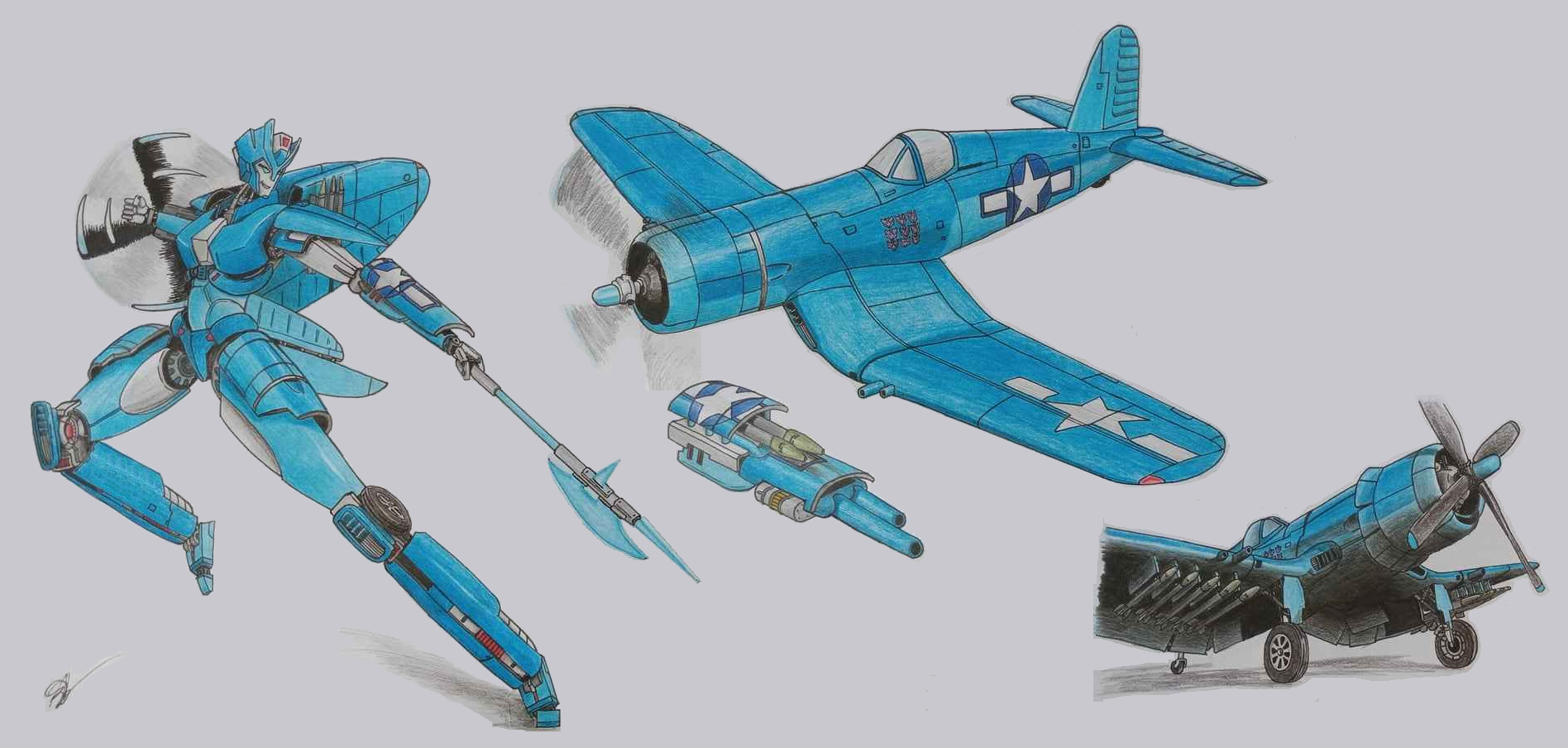 | | VF-4U Elite Veritech Fighter. |
|---|
In 2491, Major SINTAIRE began development of a Veritech version of the F-4U for potential introduction to the Civil Defense services, which are generally denied access to Vertitechnology. The project didn't quite take off like Red had hoped, and GDL stocks took a hit for a few years; During this time he bought up a lot of GDL stocks, resecuring his control of the company (eventually controlling 60% of the company). Conspiracy theorists claim he deliberately devalued the company- Charges that were never proven.The Elita isn't a true Veritech; It only has 2 modes (fighter and Battloid) and doesn't use protoculture (in fact it uses the same U-1300 Hydrocell turboprop engine the Corsair uses. However, the common term is used here to encourage non-UGC aligned systems that are receiving the craft to fully join.Mechanically, the VF-4U is exactly like the standard F-4U except in terms of speed; The VF-4U can run at up to 123 mph. The intra-wing mounted weapons become the gun pods in Battloid mode. The Mecha can also use any other hand-held weapon (shown here using a vibro axe from the canceled Hatchetman program).An early victory for the VF-4U was the Battle Of Riziim, where UGC Marine Lieutenant Colonel "Burn" DANVERS took on 12 'rouge' TIE Interceptors and 6 AAT Troop Transports, forcing half of the TIE's to return to orbit and permanently bringing down 5 of the transports; The last one was brought dowbn later the same day when it was intercepted by Alpha. This was not the only battle on Riziim that day, but Colonel DANVERS took then on all alone, where as the other waves were facing a couple dozen Veritechs. Col. DANVERS' actions that day saved over ten thousand civilians. |






